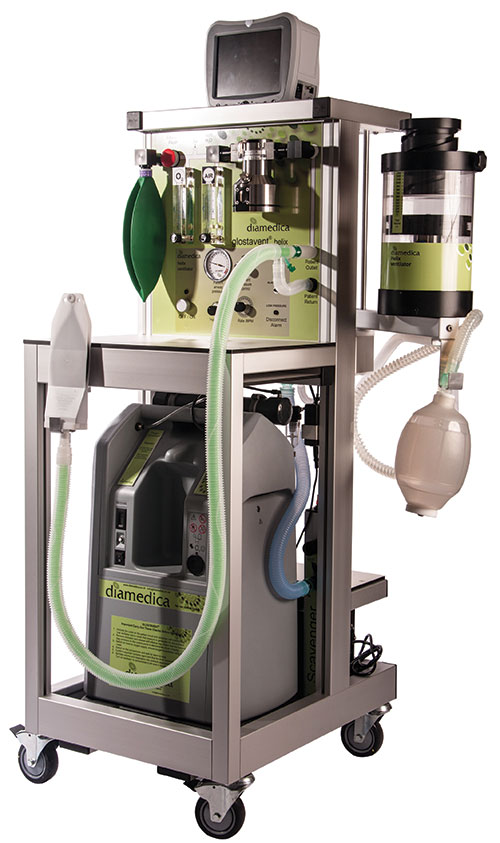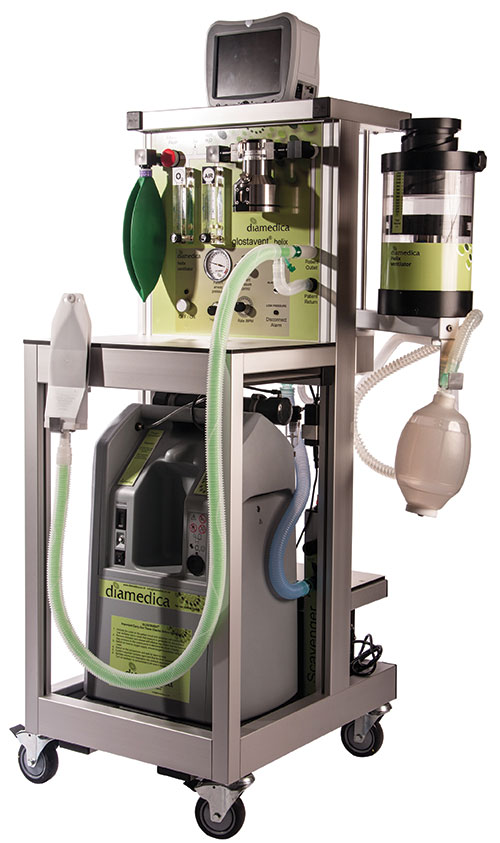ANAESTHESIA VENTILATOR (Glostavent Helix), 160-300V 46-54Hz
Valid Article
ANAESTHESIA VENTILATOR (Glostavent Helix)
Definition
A mains electricity (AC-powered) stand-alone, automatic cycling device used to assist and control alveolar ventilation during general anaesthesia, and is compatible with inhaled anaesthetic agents. It has fewer functions and is less complex to operate than an intensive care ventilator, but adequately meets the patient's ventilation needs for oxygen (O2) and carbon dioxide (CO2) exchange to maintain normal blood gas concentrations. The device provides a mechanical means to deliver the breathing gas to the patient > 10 kg in a controlled pattern, and is equipped with alarms to warn of changes in respiration or the onset of unsafe operating conditions.
Specifications
The ventilator is a time-cycled, volume limited, pressure generator. It consists of a set of gas driven bellows. The drive gas is oxygen supplied either by the concentrator or, in the event of an electricity failure, from the reserve oxygen cylinder or external oxygen source.
After it has driven the ventilator it is collected and returned to the breathing circuit to supplement the inspired oxygen concentration, always providing the patient with a minimum of 35% oxygen.
The UPS provides a reserve supply of electricity for approximately 30 minutes. It also functions as a voltage and frequency regulator.
The vaporiser can be used with isoflurane (replaces halothane).
Composed by four principal components:
- a versatile breathing system
- a pneumatically driven ventilator
- an oxygen concentrator
- an uninterruptible power supply for voltage stabilisation and battery backup
Packed in wooden case
Quality standards
Technical specifications
Ventilator
- Mode of operation Time cycled, volume limited, pressure generator
- Ventilator type Pneumatic piston driven
- Source driven by oxygen from the concentrator with cylinder back up
- Ventilation modes: SV, MV, CV, ACV
- Tidal Volume 35-1200 ml
- Inspiratory/expiratory ratio 1:2
- Alarms High and low pressure with LED indicators
- Operating temperature range 0 - 40°C
- Power supply 160 to 300V, 50+/-4 Hz, battery backup
- Battery backup life >100 hours
- Respiratory rate Up to 40 breaths/min
- Battery recharge 90% within 3 hours
- Inspiratory pressure range 5 - 50 cm water
- Weaning triggered 1 to 5 cm
- Drive pressure/volume >20psi : 1/6 minute volume
- Ventilation backup facility which will run the ventilator on room air for 12 hours in the event of a power cut
Oxygen concentrator
- 10l/min at 95%
UPS
- 1000VA Double on-line UPS.
Input voltage range 160-300 Volts, frequency range 50Hz +/- 4%
Circuit breaker protected
Dimensions
- Size and weight : 54x66x145cm, 98kg
- Packed weights and dimensions: 158x76x62cm, 165kg
Packaging & Labelling
Unit packaging, wooden box
Supplied with the Article
Glostavent® Helix complete anaesthesia system, supplied with:
- 1 x oxygen concentrator of 10 litres per min
- 1 x Ambu PEEP Valve
Specifications include:
- 1 x reusable silicone patient circuit adult
- 1 x reusable silicone patient circuit paediatric
- 1 x trolley/workstation on castors
- 1 x shelf monitor
- 1 x set of tubes to connect the ventilator, O2 concentrator and vaporiser
- 1 x patient circuit support
- 1 x vaporiser support block
- 1 x isoflurane vaporiser
- 1 x bacteriological HEPA filter
- 1 x funnel for vaporiser
- 1 x adult self inflating bag for manual ventilation
- 1 x paediatric self inflating bag for manual ventilation
- 1 x scavenger tube for expiratory valve
- 1 x pressure regulator (combined bull nose/pin index)and hose
- 1 x kit of filters
- 1 x external foam filter for oxygen concentrator
- 2 x Hepa filters
- 1 x 1000VA double on-line UPS
- 1 x user manual
- 1 x technical maintenance manual with spare parts diagrams
Instructions for use
Maintenance
Between patients and after every operating day clean and disinfect the equipment and sterilize patient circuits (see Protocol I: User Maintenance).
The manufacturer (Diamedica) issued early 2019 a field safety notice after an incident involving the failure of a battery in a Glostavent Helix anaesthesia machine. They advise a precautionary inspection of the equipment in line with a supplied checklist.





![[KMEDKHOE2CO] OPERATING THEATRE, PART med.equip. 1operating room, complete](/web/image/product.template/572548/image_256/%5BKMEDKHOE2CO%5D%20OPERATING%20THEATRE%2C%20PART%20med.equip.%201operating%20room%2C%20complete?unique=2209959)
![[DORAISOF2L-] ISOFLURANE, inhalation vapour, liquid, 250ml, bot.](/web/image/product.template/572081/image_256/%5BDORAISOF2L-%5D%20ISOFLURANE%2C%20inhalation%20vapour%2C%20liquid%2C%20250ml%2C%20bot.?unique=8a5f731)
![[KPROMPOSUA06X] MODULE UPS double convers. (Delta RT EXTEND.) 6kVA, 1ph/1ph](/web/image/product.template/577879/image_256/%5BKPROMPOSUA06X%5D%20MODULE%20UPS%20double%20convers.%20%28Delta%20RT%20EXTEND.%29%206kVA%2C%201ph-1ph?unique=df96342)
![[SCTDBRCF1A-] FILTER, BREATHING CIRCUIT, 22M/15F, adult/child, s.u.](/web/image/product.template/571898/image_256/%5BSCTDBRCF1A-%5D%20FILTER%2C%20BREATHING%20CIRCUIT%2C%2022M-15F%2C%20%20adult-child%2C%20s.u.?unique=1495f79)
![[SCTDBRCF1N-] FILTER, BREATHING CIRCUIT, 15M/15F, neonate, s.u.](/web/image/product.template/571899/image_256/%5BSCTDBRCF1N-%5D%20FILTER%2C%20BREATHING%20CIRCUIT%2C%2015M-15F%2C%20neonate%2C%20s.u.?unique=1495f79)
![[EANEANAA301] (Diamedica) ADDITIONAL TUBE, Ø 22mm 3m, 1574000A](/web/image/product.template/569670/image_256/%5BEANEANAA301%5D%20%28Diamedica%29%20ADDITIONAL%20TUBE%2C%20%C3%98%2022mm%203m%2C%201574000A?unique=357c718)
![[EANEANAA302] (Diamedica) ADDITIONAL TUBE, Ø 22mm 400mm, 1574000B](/web/image/product.template/569668/image_256/%5BEANEANAA302%5D%20%28Diamedica%29%20ADDITIONAL%20TUBE%2C%20%C3%98%2022mm%20400mm%2C%201574000B?unique=d428368)
![[EANEANAA303] (Diamedica) NON-RETURN VALVE, 22M-22F 1921000](/web/image/product.template/569588/image_256/%5BEANEANAA303%5D%20%28Diamedica%29%20NON-RETURN%20VALVE%2C%2022M-22F%201921000?unique=d428368)
![[EANEANAA305] (ventilator) T CIRCUIT MAPLESON F,22M/15F, balloon 500ml s.u](/web/image/product.template/569587/image_256/%5BEANEANAA305%5D%20%28ventilator%29%20T%20CIRCUIT%20MAPLESON%20F%2C22M-15F%2C%20balloon%20500ml%20s.u?unique=d428368)
![[EANEANAA306] (Diamedica Helix-Glostavent) OUTFLOW BLOCK CONNECTOR CP003](/web/image/product.template/570745/image_256/%5BEANEANAA306%5D%20%28Diamedica%20Helix-Glostavent%29%20OUTFLOW%20BLOCK%20CONNECTOR%20CP003?unique=8a903e8)
![[EANEANAA307] (resusc./ventilator) PEEP VALVE 20, inlet conn.30mm,reusable](/web/image/product.template/570697/image_256/%5BEANEANAA307%5D%20%28resusc.-ventilator%29%20PEEP%20VALVE%2020%2C%20inlet%20conn.30mm%2Creusable?unique=69381ac)
![[EANEANAA311] (Diamedica DPA-Helix) SELF-INFLATING BAG, adult 038-71-840-H](/web/image/product.template/570724/image_256/%5BEANEANAA311%5D%20%28Diamedica%20DPA-Helix%29%20SELF-INFLATING%20BAG%2C%20adult%20038-71-840-H?unique=c190218)
![[EANEANAA312] (Diamedica DPA-Helix) SELF-INFLATING BAG, paed. 038-72-840-H](/web/image/product.template/570723/image_256/%5BEANEANAA312%5D%20%28Diamedica%20DPA-Helix%29%20SELF-INFLATING%20BAG%2C%20paed.%20038-72-840-H?unique=66130d2)
![[EANEANAA316] (Diamedica) ADULT MASK 038-071-AM](/web/image/product.template/572574/image_256/%5BEANEANAA316%5D%20%28Diamedica%29%20ADULT%20MASK%20038-071-AM?unique=d0874aa)
![[EANEANAA317] (Diamedica) PAEDIATRIC MASK 038-071-PM](/web/image/product.template/572601/image_256/%5BEANEANAA317%5D%20%28Diamedica%29%20PAEDIATRIC%20MASK%20038-071-PM?unique=d0874aa)
![[EANEANAA401] (Diamedica DPA-Helix) EXPIRATORY VALVE PCV EX](/web/image/product.template/570639/image_256/%5BEANEANAA401%5D%20%28Diamedica%20DPA-Helix%29%20EXPIRATORY%20VALVE%20PCV%20EX?unique=91de029)
![[EANEANAA402] (Diamedica DPA-Helix) INSPIRATORY VALVE PCV IN](/web/image/product.template/570637/image_256/%5BEANEANAA402%5D%20%28Diamedica%20DPA-Helix%29%20INSPIRATORY%20VALVE%20PCV%20IN?unique=c933b24)
![[EANEANAA407] (Diamedica DPA2) T-PIECE 22mm M/M/F, 010-634](/web/image/product.template/571394/image_256/%5BEANEANAA407%5D%20%28Diamedica%20DPA2%29%20T-PIECE%2022mm%20M-M-F%2C%20010-634?unique=40a92d0)
![[EANEANAA408] (Diamedica DPA-Helix-Glostavent) RESERVOIR BAG 2 l, 2820000](/web/image/product.template/571695/image_256/%5BEANEANAA408%5D%20%28Diamedica%20DPA-Helix-Glostavent%29%20RESERVOIR%20BAG%202%20l%2C%202820000?unique=ff5425d)
![[EANEANAA409] (Diamedica DPA-Helix-Glostavent) RESERVOIR BAG 1 l, 2810000](/web/image/product.template/571696/image_256/%5BEANEANAA409%5D%20%28Diamedica%20DPA-Helix-Glostavent%29%20RESERVOIR%20BAG%201%20l%2C%202810000?unique=dfed049)
![[EANEANAA410] (Diamedica DPA-Helix-Gl) CONNECTOR straight,Ø22Mx22M 1960000](/web/image/product.template/571729/image_256/%5BEANEANAA410%5D%20%28Diamedica%20DPA-Helix-Gl%29%20CONNECTOR%20straight%2C%C3%9822Mx22M%201960000?unique=7615941)
![[EANEANAA411] (Diamedica DPA02/03-Helix) ADULT PATIENT CIRCUIT, dbl SDCL-A](/web/image/product.template/572019/image_256/%5BEANEANAA411%5D%20%28Diamedica%20DPA02-03-Helix%29%20ADULT%20PATIENT%20CIRCUIT%2C%20dbl%20SDCL-A?unique=fe4fb0c)
![[EANEANAA412] (Diamedica DPA02/03-Helix) PAED. PATIENT CIRCUIT, dbl SDCL-P](/web/image/product.template/572021/image_256/%5BEANEANAA412%5D%20%28Diamedica%20DPA02-03-Helix%29%20PAED.%20PATIENT%20CIRCUIT%2C%20dbl%20SDCL-P?unique=f9a283f)
![[EANEANAA417] (Diamedica) DOUBLE SWIVEL ELBOW 15M-22M/15F 1897 000](/web/image/product.template/570661/image_256/%5BEANEANAA417%5D%20%28Diamedica%29%20DOUBLE%20SWIVEL%20ELBOW%2015M-22M-15F%201897%20000?unique=0c94c00)
![[EANEANAA420] (Diamedica DPA02/03-Helix) PAED./ADULT Y-PIECE 002-011-1002](/web/image/product.template/582175/image_256/%5BEANEANAA420%5D%20%28Diamedica%20DPA02-03-Helix%29%20PAED.-ADULT%20Y-PIECE%20002-011-1002?unique=3009abc)
![[EANEANAA502] (Diamedica Helix-Glostavent) TUBE blue Ø 30mm, 3m 1570000B](/web/image/product.template/571727/image_256/%5BEANEANAA502%5D%20%28Diamedica%20Helix-Glostavent%29%20TUBE%20blue%20%C3%98%2030mm%2C%203m%201570000B?unique=8a903e8)
![[EANEANAA503] (Diamedica Helix-Glost) CONNECTOR straight, Ø30Mx30M 1970001](/web/image/product.template/571712/image_256/%5BEANEANAA503%5D%20%28Diamedica%20Helix-Glost%29%20CONNECTOR%20straight%2C%20%C3%9830Mx30M%201970001?unique=8a903e8)
![[EANEANAA504] (Diamedica Helix-Glost) CONNECTOR straight, Ø30Mx30F 1971001](/web/image/product.template/571715/image_256/%5BEANEANAA504%5D%20%28Diamedica%20Helix-Glost%29%20CONNECTOR%20straight%2C%20%C3%9830Mx30F%201971001?unique=8a903e8)
![[EANEANAA505] (Diamedica Helix-Glost) TUBE & MASK Oxygen set 1103-1576](/web/image/product.template/570658/image_256/%5BEANEANAA505%5D%20%28Diamedica%20Helix-Glost%29%20TUBE%20%26%20MASK%20Oxygen%20set%201103-1576?unique=8a903e8)
![[EANEANAA506] (Diamedica Helix-Glost) METAL TRAY, GN14-65](/web/image/product.template/570673/image_256/%5BEANEANAA506%5D%20%28Diamedica%20Helix-Glost%29%20METAL%20TRAY%2C%20GN14-65?unique=8a903e8)
![[EANEANAA507] (Diamedica Helix-Glost) MALE CONNECTOR M Connector](/web/image/product.template/570610/image_256/%5BEANEANAA507%5D%20%28Diamedica%20Helix-Glost%29%20MALE%20CONNECTOR%20M%20Connector?unique=8a903e8)
![[EANEANAA508] (Diamedica Helix-Glost) FEMALE CONNECTOR F Connector](/web/image/product.template/570613/image_256/%5BEANEANAA508%5D%20%28Diamedica%20Helix-Glost%29%20FEMALE%20CONNECTOR%20F%20Connector?unique=8a903e8)
![[EANEANAA509] (Diamedica Helix-Glost) OXYGEN HOSE 2m OXY-A/SH-A](/web/image/product.template/570608/image_256/%5BEANEANAA509%5D%20%28Diamedica%20Helix-Glost%29%20OXYGEN%20HOSE%202m%20OXY-A-SH-A?unique=8a903e8)
![[EANEANAA510] (Diamedica Glostavent, DPA, DPA2/3) SEVO. FILTER, SF-VALVE](/web/image/product.template/587402/image_256/%5BEANEANAA510%5D%20%28Diamedica%20Glostavent%2C%20DPA%2C%20DPA2-3%29%20SEVO.%20FILTER%2C%20SF-VALVE?unique=d64833f)
![[EANEANAA511] (Diamedica Glostavent, DPA, DPA2/3) VAPORISER STAND TPS2300](/web/image/product.template/588218/image_256/%5BEANEANAA511%5D%20%28Diamedica%20Glostavent%2C%20DPA%2C%20DPA2-3%29%20VAPORISER%20STAND%20TPS2300?unique=961d6a3)
![[EANEANAA606] (Diamedica Helix/Glost) 3 WAYS CONNECTOR, 22xM/M/F, 1982000](/web/image/product.template/569605/image_256/%5BEANEANAA606%5D%20%28Diamedica%20Helix-Glost%29%203%20WAYS%20CONNECTOR%2C%2022xM-M-F%2C%201982000?unique=8afa4f0)
![[EEMDCPAA620] (Diamedica) CONNECTOR Straight Ø 22F - 15M, 1962000](/web/image/product.template/572999/image_256/%5BEEMDCPAA620%5D%20%28Diamedica%29%20CONNECTOR%20Straight%20%C3%98%2022F%20-%2015M%2C%201962000?unique=e6371ed)
![[EANEANAE51-] (Diamedica Helix-Glost) CONCENTRATOR O2 10l, AS099-10-MGV](/web/image/product.template/572917/image_256/%5BEANEANAE51-%5D%20%28Diamedica%20Helix-Glost%29%20CONCENTRATOR%20O2%2010l%2C%20AS099-10-MGV?unique=8a903e8)
![[EANEANAS302] (Diamedica) VAPORISER SERVICE KIT 3400](/web/image/product.template/572592/image_256/%5BEANEANAS302%5D%20%28Diamedica%29%20VAPORISER%20SERVICE%20KIT%203400?unique=9a9a8cf)
![[EANEANAS501] (Diamedica Helix-Glost-CPAP) WATER TRAP 398 9091-MOD](/web/image/product.template/571713/image_256/%5BEANEANAS501%5D%20%28Diamedica%20Helix-Glost-CPAP%29%20WATER%20TRAP%20398%209091-MOD?unique=89ede08)
![[EANEANAS502] (Diamedica Helix-Glostavent) BATTERY CHARGER 120-4138](/web/image/product.template/571710/image_256/%5BEANEANAS502%5D%20%28Diamedica%20Helix-Glostavent%29%20BATTERY%20CHARGER%20120-4138?unique=89ede08)
![[EANEANAS503] (Diamedica Helix) CONTROL PANEL battery 537-5472](/web/image/product.template/571709/image_256/%5BEANEANAS503%5D%20%28Diamedica%20Helix%29%20CONTROL%20PANEL%20battery%20537-5472?unique=e1c09a5)
![[EANEANAS504] (Diamedica Helix-Glostavent) BATTERY, UPS, set of 3 RBS/UPS](/web/image/product.template/571711/image_256/%5BEANEANAS504%5D%20%28Diamedica%20Helix-Glostavent%29%20BATTERY%2C%20UPS%2C%20set%20of%203%20RBS-UPS?unique=89ede08)
![[EANEANAS505] (Diamedica Helix-Glostavent) CIRCUIT BOARD,ventilator CBV-GV](/web/image/product.template/571752/image_256/%5BEANEANAS505%5D%20%28Diamedica%20Helix-Glostavent%29%20CIRCUIT%20BOARD%2Cventilator%20CBV-GV?unique=89ede08)
![[EANEANAS506] (Diamedica Helix-Glost) COMPRESSOR SERVICE KIT CONC.CO012-11](/web/image/product.template/569905/image_256/%5BEANEANAS506%5D%20%28Diamedica%20Helix-Glost%29%20COMPRESSOR%20SERVICE%20KIT%20CONC.CO012-11?unique=89ede08)
![[EANEANAS507] (Diamedica Helix-Glostavent) FUSE FOR VENTILATOR, 563-609A](/web/image/product.template/571002/image_256/%5BEANEANAS507%5D%20%28Diamedica%20Helix-Glostavent%29%20FUSE%20FOR%20VENTILATOR%2C%20563-609A?unique=89ede08)
![[EANEANAS508] (Diamedica Helix-Glostavent) SOLENOID VALVE SY3220-6LOU-M5](/web/image/product.template/568602/image_256/%5BEANEANAS508%5D%20%28Diamedica%20Helix-Glostavent%29%20SOLENOID%20VALVE%20SY3220-6LOU-M5?unique=89ede08)
![[EANEANAS509] (Diamedica Helix-Glostavent) OXYGEN FLOWMETER FL-2040-O](/web/image/product.template/568636/image_256/%5BEANEANAS509%5D%20%28Diamedica%20Helix-Glostavent%29%20OXYGEN%20FLOWMETER%20FL-2040-O?unique=89ede08)
![[EANEANAS510] (Diamedica Helix-glostavent) OVER PRESSURE VALVE OPV/001](/web/image/product.template/568637/image_256/%5BEANEANAS510%5D%20%28Diamedica%20Helix-glostavent%29%20OVER%20PRESSURE%20VALVE%20OPV-001?unique=89ede08)
![[EANEANAS511] (Diamedica Helix-Glostavent) FLOWMETER REGULATOR 492-8570](/web/image/product.template/568633/image_256/%5BEANEANAS511%5D%20%28Diamedica%20Helix-Glostavent%29%20FLOWMETER%20REGULATOR%20492-8570?unique=89ede08)
![[EANEANAS512] (Diamedica Helix-Glostavent) LOOM for ventilator CBV-L](/web/image/product.template/571870/image_256/%5BEANEANAS512%5D%20%28Diamedica%20Helix-Glostavent%29%20LOOM%20for%20ventilator%20CBV-L%C2%A0?unique=77ae51b)
![[EANEANAS513] (Diamedica Helix-Glost-CPAP) AIR REGULATOR 435-9609-MOD](/web/image/product.template/571872/image_256/%5BEANEANAS513%5D%20%28Diamedica%20Helix-Glost-CPAP%29%20AIR%20REGULATOR%20435-9609-MOD?unique=a4cfd1e)
![[EANEANAS514] (Diamedica Helix-Glost) VENTILATOR FLOW REGULATOR 748-0709](/web/image/product.template/571867/image_256/%5BEANEANAS514%5D%20%28Diamedica%20Helix-Glost%29%20VENTILATOR%20FLOW%20REGULATOR%20748-0709?unique=77ae51b)
![[EANEANAS515] (Diamedica Helix-Glostavent) SCAVENGER UNIT, SCAV-GV](/web/image/product.template/571869/image_256/%5BEANEANAS515%5D%20%28Diamedica%20Helix-Glostavent%29%20SCAVENGER%20UNIT%2C%20SCAV-GV?unique=77ae51b)
![[EANEANAS516] (Diamedica Helix-Glostavent) OXYGEN FLUSH VALVE, VM130/VM30](/web/image/product.template/571864/image_256/%5BEANEANAS516%5D%20%28Diamedica%20Helix-Glostavent%29%20OXYGEN%20FLUSH%20VALVE%2C%20VM130-VM30?unique=77ae51b)
![[EANEANAS517] (Diamedica Helix-Glostavent) FILTER BACK DOOR, FI002-1-BD](/web/image/product.template/571865/image_256/%5BEANEANAS517%5D%20%28Diamedica%20Helix-Glostavent%29%20FILTER%20BACK%20DOOR%2C%20FI002-1-BD?unique=77ae51b)
![[EANEANAS518] (conc.10l Diamedica Helix-Glost) HEPA FILTER, PV5LD-651](/web/image/product.template/572911/image_256/%5BEANEANAS518%5D%20%28conc.10l%20Diamedica%20Helix-Glost%29%20HEPA%20FILTER%2C%20PV5LD-651?unique=77ae51b)
![[EANEANAS519] (conc.10l Diamedica Helix-Glost) CAPACITOR, CC012-7](/web/image/product.template/572913/image_256/%5BEANEANAS519%5D%20%28conc.10l%20Diamedica%20Helix-Glost%29%20CAPACITOR%2C%20CC012-7?unique=77ae51b)
![[EANEANAS521] (conc.10l Diamedica Helix-Glost) REDUCER O2](/web/image/product.template/581548/image_256/%5BEANEANAS521%5D%20%28conc.10l%20Diamedica%20Helix-Glost%29%20REDUCER%20O2?unique=77ae51b)
![[EANEANAS522] (Diamedica Helix-Glost) UPS MAINS CABLE EU PLUG 42 0563](/web/image/product.template/571831/image_256/%5BEANEANAS522%5D%20%28Diamedica%20Helix-Glost%29%20UPS%20MAINS%20CABLE%20EU%20PLUG%2042%200563?unique=77ae51b)
![[EANEANAS523] (Diamedica Helix-Glost) UPS MAINS CABLE UK PLUG 42 3287](/web/image/product.template/571829/image_256/%5BEANEANAS523%5D%20%28Diamedica%20Helix-Glost%29%20UPS%20MAINS%20CABLE%20UK%20PLUG%2042%203287?unique=3f669f7)
![[EANEANAS524] (Diamedica Helix-Glost-CPAP) BLACK TUBING 6mm 1m 721-4007-A](/web/image/product.template/571827/image_256/%5BEANEANAS524%5D%20%28Diamedica%20Helix-Glost-CPAP%29%20BLACK%20TUBING%206mm%201m%20721-4007-A?unique=3f669f7)
![[EANEANAS525] (Diamedica Helix-Glostavent) DUO CONTROL PANEL, 2 vaporisers](/web/image/product.template/572648/image_256/%5BEANEANAS525%5D%20%28Diamedica%20Helix-Glostavent%29%20DUO%20CONTROL%20PANEL%2C%202%20vaporisers?unique=3f669f7)
![[EANEANAS526] (Diamedica Helix-Glost) NON RETURN VALVE 367-0624](/web/image/product.template/569601/image_256/%5BEANEANAS526%5D%20%28Diamedica%20Helix-Glost%29%20NON%20RETURN%20VALVE%20367-0624?unique=3f669f7)
![[EANEANAS527] (Diamedica Helix-Glost) EXTERNAL AIR REGULATOR AR20-F01B-B](/web/image/product.template/569640/image_256/%5BEANEANAS527%5D%20%28Diamedica%20Helix-Glost%29%20EXTERNAL%20AIR%20REGULATOR%20AR20-F01B-B?unique=3f669f7)
![[EANEANAS528] (Diamedica Helix-Glost) PRESSURE REGULATOR fr O2cyl.819-0017](/web/image/product.template/569642/image_256/%5BEANEANAS528%5D%20%28Diamedica%20Helix-Glost%29%20PRESSURE%20REGULATOR%20fr%20O2cyl.819-0017?unique=3f669f7)
![[EANEANAS529] (Diamedica Helix-Glost) LOW PRESSURE GAUGE PGL-25L-35-GV](/web/image/product.template/570663/image_256/%5BEANEANAS529%5D%20%28Diamedica%20Helix-Glost%29%20LOW%20PRESSURE%20GAUGE%20PGL-25L-35-GV?unique=3f669f7)
![[EANEANAS530] (Diamedica Helix-Glost) BLACK ALUMINIUM KNOB 498-839](/web/image/product.template/570665/image_256/%5BEANEANAS530%5D%20%28Diamedica%20Helix-Glost%29%20BLACK%20ALUMINIUM%20KNOB%20498-839?unique=3f669f7)
![[EANEANAS531] (Diamedica Helix-Glost-CPAP) MUFFLER for 10l conc. MU043-2S](/web/image/product.template/570669/image_256/%5BEANEANAS531%5D%20%28Diamedica%20Helix-Glost-CPAP%29%20MUFFLER%20for%2010l%20conc.%20MU043-2S?unique=3f669f7)
![[EANEANAS532] (Diamedica Helix-Glost) REPLACEMENT UPS C400-020-B12](/web/image/product.template/570671/image_256/%5BEANEANAS532%5D%20%28Diamedica%20Helix-Glost%29%20REPLACEMENT%20UPS%20C400-020-B12?unique=de1be9f)
![[EANEANAS533] (Diamedica Helix-Glost) BULL NOSE O2 CONNECTOR pin 160201-O2](/web/image/product.template/570603/image_256/%5BEANEANAS533%5D%20%28Diamedica%20Helix-Glost%29%20BULL%20NOSE%20O2%20CONNECTOR%20pin%20160201-O2?unique=de1be9f)
![[EANEANAS534] (Diamedica Helix) PRESSURE REGULATOR 50.780.00.10.00](/web/image/product.template/570605/image_256/%5BEANEANAS534%5D%20%28Diamedica%20Helix%29%20PRESSURE%20REGULATOR%2050.780.00.10.00?unique=de1be9f)
![[EANEANAS535] (Diamedica Helix-Glost) PEEP VALVE CASING, A213-PEEP-CAS](/web/image/product.template/578635/image_256/%5BEANEANAS535%5D%20%28Diamedica%20Helix-Glost%29%20PEEP%20VALVE%20CASING%2C%20A213-PEEP-CAS?unique=263d889)
![[EANEANAS536] (Diamedica Helix-Glost) OXYGEN SENSOR for GOX100T 60-3737](/web/image/product.template/580234/image_256/%5BEANEANAS536%5D%20%28Diamedica%20Helix-Glost%29%20OXYGEN%20SENSOR%20for%20GOX100T%2060-3737?unique=7ad0f10)
![[EANEANAS537] (Diamedica Helix-Glost) PEEP VALVE CONNECTOR 22mm GV PEEP 22](/web/image/product.template/587878/image_256/%5BEANEANAS537%5D%20%28Diamedica%20Helix-Glost%29%20PEEP%20VALVE%20CONNECTOR%2022mm%20GV%20PEEP%2022?unique=f9ccab8)
![[EANEANAS538] (Diamedica Helix-Glost) OXYGEN PRESSURE RESERVOIR GV O2](/web/image/product.template/587877/image_256/%5BEANEANAS538%5D%20%28Diamedica%20Helix-Glost%29%20OXYGEN%20PRESSURE%20RESERVOIR%20GV%20O2?unique=8545435)
![[EANEANAS539] (Diamedica Helix-Glost) CHECK VALVE CH-VALVE001](/web/image/product.template/587570/image_256/%5BEANEANAS539%5D%20%28Diamedica%20Helix-Glost%29%20CHECK%20VALVE%20CH-VALVE001?unique=7ceed2a)
![[EANEANAS540] (Diamedica Helix-Glost) POLYCARBONATE TUBE PC-GVH-VENT](/web/image/product.template/587622/image_256/%5BEANEANAS540%5D%20%28Diamedica%20Helix-Glost%29%20POLYCARBONATE%20TUBE%20PC-GVH-VENT?unique=4fa941f)
![[EANEANAS541] (Diamedica Helix-Glost) UPS BATTERY set of 4, RBS/UPS-C400](/web/image/product.template/587811/image_256/%5BEANEANAS541%5D%20%28Diamedica%20Helix-Glost%29%20UPS%20BATTERY%20set%20of%204%2C%20RBS-UPS-C400?unique=4fa941f)
![[EANEANAS601] (Diamedica Helix-Glostavent) AIR FLOWMETER FL-2040-A](/web/image/product.template/571292/image_256/%5BEANEANAS601%5D%20%28Diamedica%20Helix-Glostavent%29%20AIR%20FLOWMETER%20FL-2040-A?unique=de1be9f)
![[EEMDCONS504] (conc. NL Intensity 10l) SIEVE BED, 2 pcs, BE186-2S](/web/image/product.template/570519/image_256/%5BEEMDCONS504%5D%20%28conc.%20NL%20Intensity%2010l%29%20SIEVE%20BED%2C%202%20pcs%2C%20BE186-2S?unique=342dcd9)